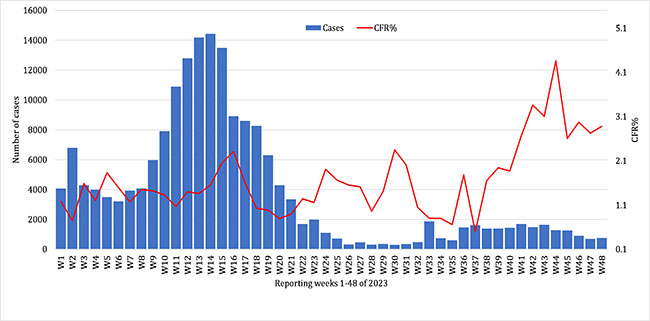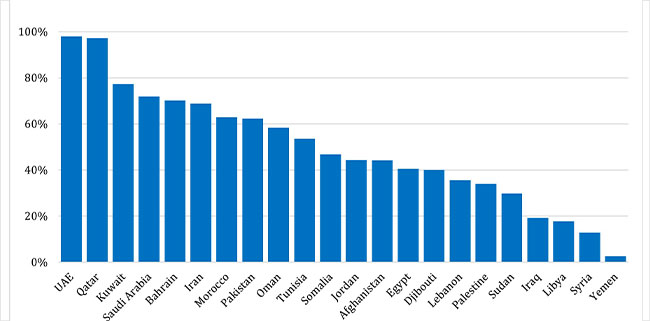As of 2 December 2023, the global cumulative incidence of COVID-19 reached 772,143,014 reported cases and 7,003,610 associated deaths, with a case-fatality ratio (CFR) of 0.91%. Meanwhile, the Eastern Mediterranean Region (EMR) has reported 23,406,897 cases, representing 3.03% of the global count, with 351,822 associated deaths (CFR 1.5%). Most countries in the Region are in the community transmission phase. This report does not represent the accurate COVID-19 burden in the EMR, given that updates are not regularly received from all 22 Member States (Table 1).

Table 1: COVID-19 cases, deaths, and CFR, global and EMR, as of 2 December 2023
During the epidemiological week 48 of 2023, a total of 764 lab-confirmed COVID-19 cases and 22 associated deaths (CFR: 2.9%) were reported from 4 Member States: Afghanistan (347 cases; 2 death), IR Iran (292 cases; 19 deaths), Kuwait (9 cases; 0 death) and Morocco (116 cases; 1 death). This indicates a 10% and 16% increase in the number of cases and deaths respectively compared to week 47.
A total of 64,067 COVID-19 PCR tests were conducted this week in the 3 Member States (Positivity Rate: 1.2%) which indicates a 23% increase in the number of tests compared to the previous week. This brings the cumulative number of COVID-19 laboratory tests in EMR to 450,320,578 (positivity rate 5.2%) since the start of the pandemic. The highest number of PCR tests were reported from the United Arab Emirates (UAE) (200,761,593; 44.6%), followed by IR Iran (58,125,479; 12.9%), and Saudi Arabia (45,484,848; 10.1%). WHO recommends a positivity rate of around 3–12% as a general benchmark indicating adequate testing, which was achieved in most countries of the Region.
Since the beginning of the pandemic, the highest number of total cases in the Region was reported by IR Iran (7,624,699; 32.57% of the Region’s total), followed by Iraq (2,465,545; 10.53%), and Jordan (1,746,997; 7.46%). IR Iran also reported the highest number of total COVID-19-associated deaths (146,724; 41.70% of the Region’s total) followed by Pakistan (30,656; 8.71%) and Tunisia (29,423; CFR 8.36%). The lowest CFRs in the region were reported by Qatar (0.13%), Bahrain (0.22), and the UAE (0.22%), while the highest CFRs were reported by Yemen (18.07%) followed by Sudan (7.89%) and Syria (5.51%) respectively.

Graph 1: Epidemiological curve of COVID-19 laboratory confirmed cases and CFR, EMR, January- November 2023
WHO Support to the Member States of the Region
The regional incident management support team (IMST) continues to coordinate the response and provide technical support to the Member States and partners in the Region in the areas of coordination and partnership, surveillance, laboratory capacity, clinical management, infection prevention and control, risk communication and community engagement, points of entry according to the International Health Regulations (2005), research, health systems, and essential health services among others. Furthermore, COVID-19 vaccination continues to be provided across the Region. The total number of doses administered as of 2 December 2023 in the 22 Member States is 902,709,401 and the average coverage of fully vaccinated population in the Region is 51%. The highest coverage rate of complete primary series was reported from the UAE (98%), followed by Qatar (97%), and Kuwait (77%) while the lowest coverage rate was reported by Yemen (3%) followed by Syria (13%) and Libya (18%), (Figure 2).

Graph 2: COVID-19 vaccine coverage by EMR Member States, December 2023
For more data from the Region, please visit the COVID-19 dashboard.
*The data on vaccination is obtained from several sources including media reports and country websites for ministries of health.
* We are currently reporting on weekly relative differences instead of cumulative differences to better reflect the extent of the COVID-19 pandemic as we are witnessing a decline in the reported cases. In addition, to a change in the frequency and quality of data sharing, countries started to move to weekly aggregate data, and less information is shared by countries. Subscribe to the monthly infectious hazard preparedness newsletter of WHO’s Health Emergencies Programme for the latest data and analysis on the epidemic- and pandemic-prone diseases, as well as news on outbreak preparedness and response within WHO’s Eastern Mediterranean Region.








